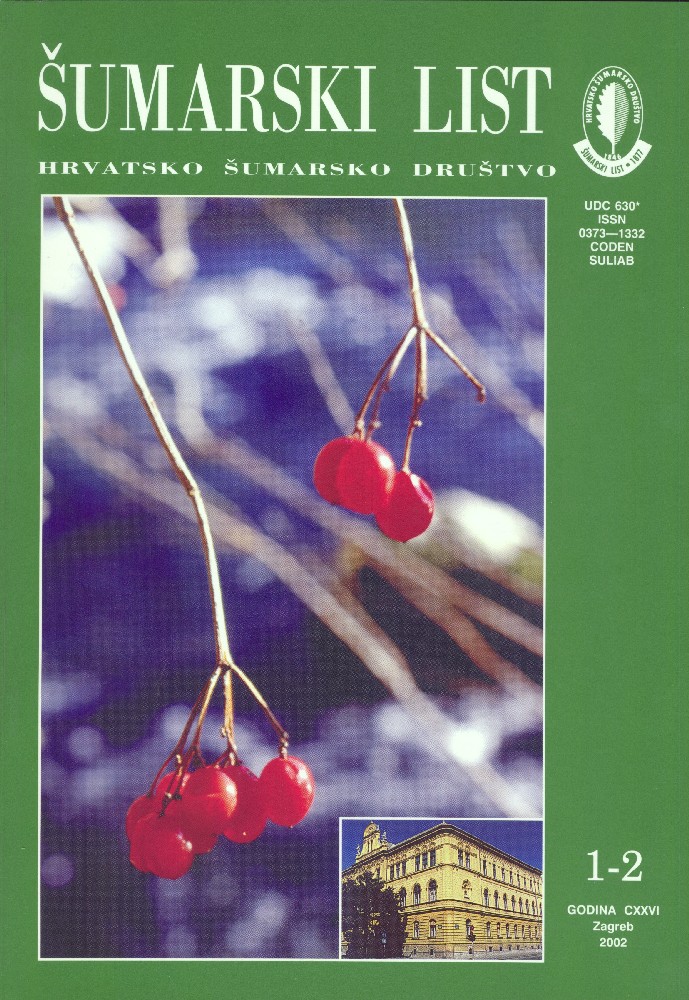
broj: 1-2/2002
pdf (28,5 MB) |
|
||||||||||||||
| IZVORNI ZNANSTVENI ČLANCI | ||
| Žíhlavník, A. | UDK 630* 624 + 231 (001) | |
| Felling Control in Near-natural Forest Management pdf HR EN | 3 | |
| Cerovečki, Z. | UDK 630* 188 + 181.3 (001) | |
| Numerical Determination of Climatic and Edaphic Factors of the Habitats in the Forest Phytocoenoses of the Maceljsko Gorje Mountain pdf HR EN | 11 | |
| PREGLEDNI ČLANCI | ||
| Idžojtić, M., Ivanović, Ž. | UDK 630* 961 | |
| Women in Croatian Forestry pdf HR EN | 23 | |
| Schneider-Jacoby, M. | UDK 630* 626.1 + 630* 469 + 429 | |
| A Utopian Plan Devours Means and Landscapes in Croatia pdf HR EN | 29 | |
| Sabadi, R. | UDK 630* 909 + 83 + 72 | |
| Spain - Forestry and Forest Policy; Timber Processing and Trade pdf HR EN | 35 | |
| Summary: Spain covers an area of 504 782 km2, and it is the second large country of European Fifteen (EU), comprising 15.6 % of the territory of the EU, with 39.4 million inhabitants or 10.6 % of the total population of the EU, thus being the fifth in the EU.Historically rich country, due to centuries maintained invasions and wars, migratory movements, changes in climate which ocurred about the year 1000 c.e., when in the short time the climate changed and turned the land into arid and semiarid area, where agricultural land was obtained by clearing and burnig, is poorly endowned with forests. The greatest part of the Central plateau and southern Mediterranean littoral, meseta, belongs to the arid zone, its population being forced to the multiple use of soil, damageous for forest. Mesophytic forests on more humid places are relativelly rare, and situated mainly on the north, partly in mountains of Galicia, Asturia, Old Castille, Navarra, Aragon and Catalonia. Forest and forest land comprises about 25 million ha, but covered by forest is only 12 million ha. Tree species are distributed in accordance with the climatic conditions, growing stock is composed 71 % of broadleaved, and 29 % of coniferous trees. The annual increment is about 30 million m3, the annual felling in forests is about 16 million m3, plus 3.2 million m3 timber felled outside forest. Taking into account the accelerated industrial development, Spain is more and more dependent upon imports of wood and products made thereof. About one third of sawnwood is being imported, from domestic production only plywood consumption is selfsufficient, about one third of apparent consumption of particleboard and fibreboard of all kinds is also being imported. Production of wood pulp and paper is based on mechanical and chemical pulp, which gener-ally satisfy the greatest part of consumption. The consumption of paper and paperboard grows parallel with the industrial development. The same is the case with wood and wooden products, in one and half decade from 1980 the consumption in several items has grown even more than 50 %. Imports and exports are being quadrupled in the same period, imports being about 2.23 times larger than exports. Unfavorable trends will continue in the future, regardless of the huge efforts in afforestation, erosion, flood and torrent control , as well as forest fires control, etc. The total number of employees in forestry is about 32,200 (0.23 % from the total employ-ment), and in timber industries 144,000 (1.04 % from the total). Gross domestic product (GDP) in forestry is about 0.17 %, and in forest industries inclusive paper and paperboard industries is 0.72 % from the national GDP. Spain is significantly decentralised country with strong regional even separatistic tenden-cies, which is a considerable obstacle to the efficiency of promotive measures in forestry and upon it based industries, particularly in the private sector of ownership, characterised with low efficiency and dispersion. Key words: Forest education; Forestry and forest policy; Gross domestic product; Timber trade; Woodworking Employment in forestry and forest industries | ||
| Frković, A. | UDK 630* 149 (Vulpes sp.) + 902 | |
| Foresters Rudolf and Arthur Bergan and the Silver Fox Farm in Gorski Kotar pdf HR EN | 59 | |
| Kajba, D., Bogdan, S. | UDK 630* 165 (Populus nigra L.) | |
| Seventh Euforgen Populus Nigra Network Meeting in Osijek, Croatia, 25 - 27 October 2001. pdf HR EN | 69 | |
| STRUČNI ČLANCI | ||
| Tustonjić, A., Kružić, T. | UDK 630* 861 + 654 + 426 | |
| Forestry and Wood Industry - Croatian Prospects pdf HR EN | 77 | |


